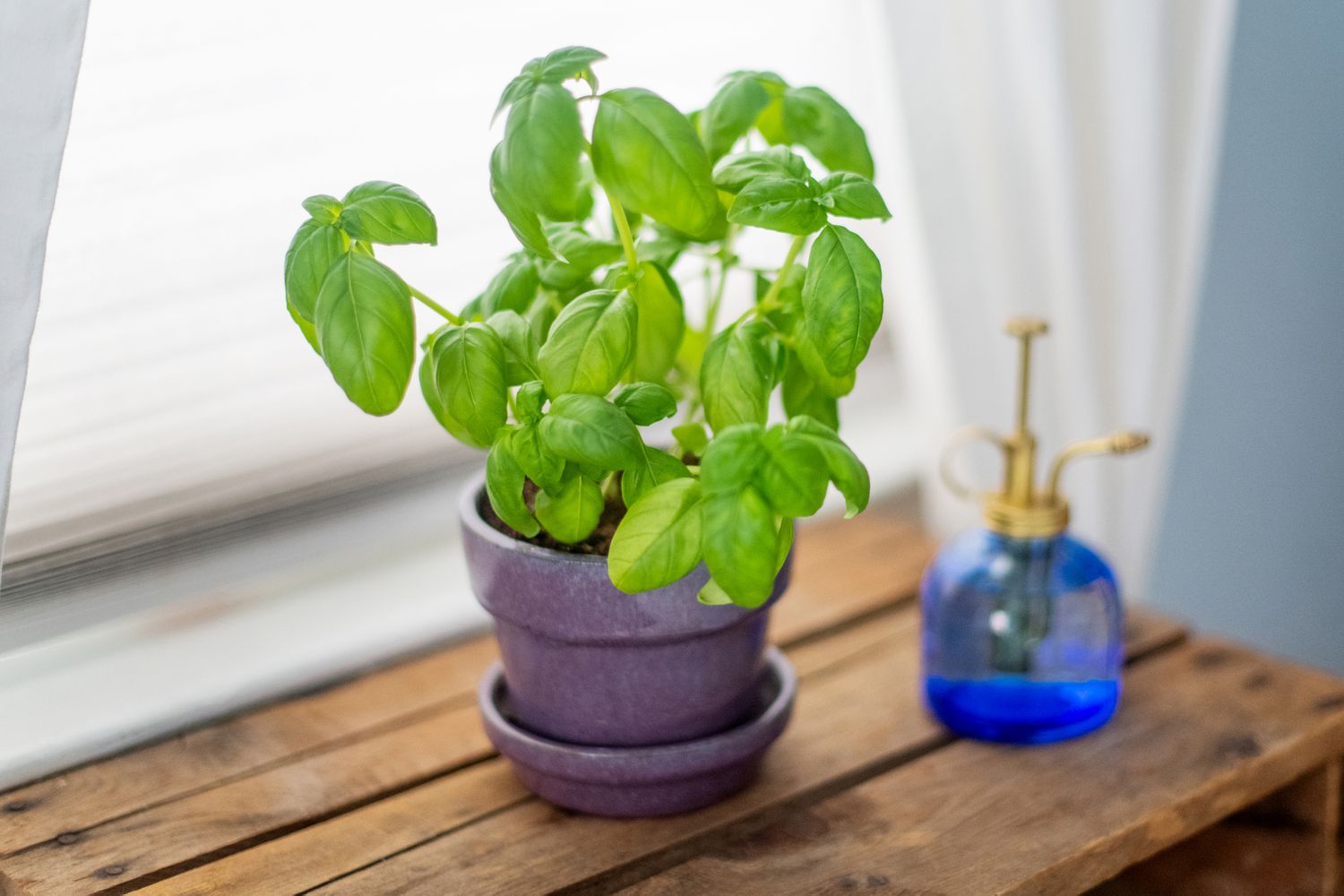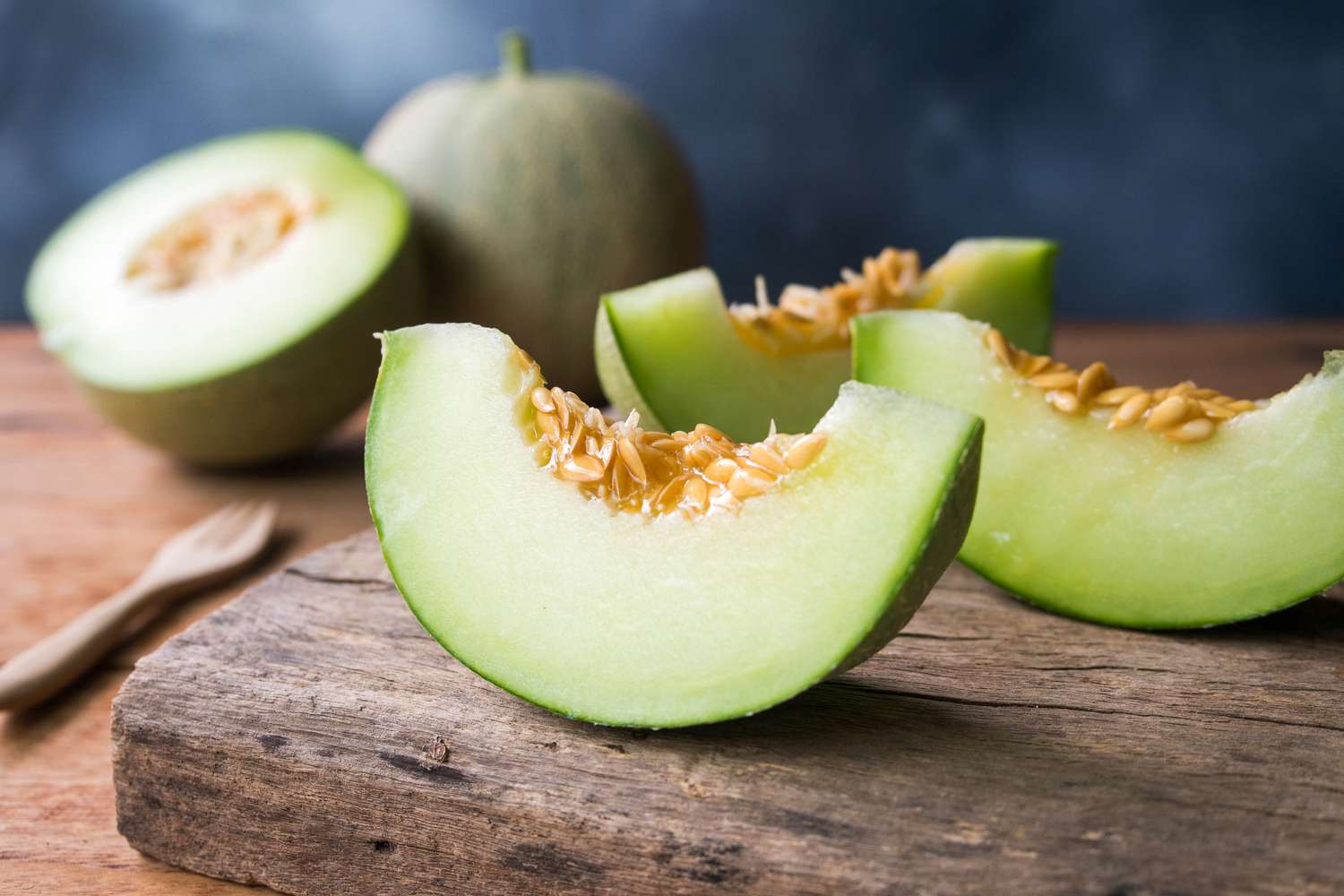Home>Home and Garden>Causes And Solutions For Black Spots On Basil Leaves


Home and Garden
Causes And Solutions For Black Spots On Basil Leaves
Modified: February 27, 2024
Learn about the causes of black spots on basil leaves and discover effective home and garden solutions to keep your plants healthy and thriving. Explore expert tips and advice for maintaining vibrant basil plants.
(Many of the links in this article redirect to a specific reviewed product. Your purchase of these products through affiliate links helps to generate commission for Noodls.com, at no extra cost. Learn more)
Table of Contents
Introduction
Basil, with its vibrant green leaves and distinctive aroma, is a beloved herb in the home garden. Whether used in culinary creations or as a natural insect repellent, basil is a versatile and valuable addition to any garden. However, the appearance of black spots on basil leaves can be a cause for concern among gardeners. These unsightly blemishes not only detract from the plant's visual appeal but also indicate underlying issues that need to be addressed.
The presence of black spots on basil leaves can be attributed to various factors, including fungal and bacterial infections, as well as environmental stress. Identifying the root cause of these black spots is crucial in implementing effective solutions to restore the health and vitality of the basil plant. By understanding the underlying reasons for the development of black spots, gardeners can take proactive measures to prevent their occurrence and promote the overall well-being of their basil plants.
In this comprehensive guide, we will delve into the causes of black spots on basil leaves, shedding light on the various factors that contribute to this issue. Furthermore, we will explore practical and sustainable solutions aimed at addressing the root causes of black spots and restoring the basil plant to its optimal state of health. By equipping ourselves with the knowledge and strategies outlined in this guide, we can nurture thriving basil plants that are free from the unsightly presence of black spots.
Causes of Black Spots on Basil Leaves
The appearance of black spots on basil leaves can be attributed to several underlying causes, each of which can significantly impact the health and vitality of the plant. Understanding these factors is essential in effectively addressing the issue and implementing targeted solutions to restore the basil plant to its optimal state. The following are the primary causes of black spots on basil leaves:
Fungal Infections
Fungal infections, such as downy mildew and fusarium wilt, are common culprits behind the development of black spots on basil leaves. These infections thrive in warm, humid conditions, making basil plants particularly susceptible, especially during periods of excessive moisture. The presence of black spots accompanied by yellowing or wilting leaves is indicative of a potential fungal infection.
Bacterial Infections
Bacterial infections, notably bacterial leaf spot, can manifest as dark, water-soaked lesions on basil leaves, eventually turning black as the infection progresses. These infections often spread rapidly in moist environments, posing a threat to the overall health of the basil plant. The presence of black spots with irregular margins and a slimy texture is indicative of a potential bacterial infection.
Environmental Stress
Environmental stress, including overwatering, poor air circulation, and inadequate sunlight, can weaken the basil plant's natural defenses, making it more susceptible to diseases and infections. Excessive moisture on the leaves, particularly in the absence of proper air circulation, creates an ideal environment for fungal and bacterial pathogens to thrive, leading to the development of black spots on the leaves.
Identifying the specific cause of black spots on basil leaves is crucial in implementing targeted solutions to address the underlying issue. By recognizing the signs associated with fungal and bacterial infections, as well as understanding the impact of environmental stress, gardeners can take proactive measures to restore the health and vitality of their basil plants.
The next section will delve into practical and sustainable solutions aimed at addressing the root causes of black spots on basil leaves, equipping gardeners with the knowledge and strategies needed to promote the overall well-being of their basil plants.
Fungal Infections
Fungal infections pose a significant threat to the health and vitality of basil plants, often leading to the development of unsightly black spots on the leaves. Among the various fungal pathogens that can affect basil, downy mildew and fusarium wilt are particularly notorious for causing black spots and compromising the overall well-being of the plant.
Downy Mildew
Downy mildew, caused by the fungal pathogen Peronospora belbahrii, is a common culprit behind the emergence of black spots on basil leaves. This destructive disease thrives in warm, humid conditions, making it particularly prevalent during periods of excessive moisture. The initial signs of downy mildew include the appearance of yellow spots on the upper surface of the leaves, often accompanied by a downy white or gray growth on the undersides. As the infection progresses, these yellow spots may turn brown and eventually black, leading to the formation of conspicuous black spots on the basil leaves.
Fusarium Wilt
Fusarium wilt, caused by the soil-borne fungus Fusarium oxysporum, is another fungal infection that can result in the development of black spots on basil leaves. This pathogen attacks the vascular system of the plant, disrupting the flow of water and nutrients and causing wilting and yellowing of the leaves. In advanced stages of the infection, the affected leaves may develop black spots, signaling the severe impact of the fungal wilt on the basil plant.
Addressing Fungal Infections
To combat fungal infections and prevent the formation of black spots on basil leaves, implementing proactive measures is essential. Proper cultural practices, including ensuring adequate air circulation, avoiding overhead watering, and maintaining appropriate spacing between plants, can help mitigate the risk of fungal infections. Additionally, applying organic fungicides, such as neem oil or copper-based solutions, can provide effective control of fungal pathogens while minimizing the impact on the environment.
By understanding the nature of fungal infections and their detrimental effects on basil plants, gardeners can take informed steps to protect their beloved herbs from the threat of black spots. Through vigilance, proper care, and timely intervention, the impact of fungal infections can be minimized, allowing basil plants to thrive and flourish without the burden of unsightly black spots on their leaves.
Read more: How To Dry Basil
Bacterial Infections
Bacterial infections pose a significant threat to the health and vitality of basil plants, often leading to the development of unsightly black spots on the leaves. Among the various bacterial pathogens that can affect basil, bacterial leaf spot is particularly notorious for causing black spots and compromising the overall well-being of the plant.
Bacterial Leaf Spot
Bacterial leaf spot, caused by the bacterium Pseudomonas cichorii, is a common culprit behind the emergence of black spots on basil leaves. This destructive disease thrives in warm, humid conditions, making it particularly prevalent during periods of excessive moisture. The initial signs of bacterial leaf spot include the appearance of dark, water-soaked lesions on the leaves, often accompanied by a slimy texture. As the infection progresses, these lesions may turn black, leading to the formation of conspicuous black spots on the basil leaves.
Addressing Bacterial Infections
To combat bacterial infections and prevent the formation of black spots on basil leaves, implementing proactive measures is essential. Proper cultural practices, including avoiding overhead watering, providing adequate spacing between plants to promote air circulation, and ensuring proper sanitation by removing and disposing of infected plant debris, can help mitigate the risk of bacterial infections. Additionally, applying organic copper-based fungicides can provide effective control of bacterial pathogens while minimizing the impact on the environment.
By understanding the nature of bacterial infections and their detrimental effects on basil plants, gardeners can take informed steps to protect their beloved herbs from the threat of black spots. Through vigilance, proper care, and timely intervention, the impact of bacterial infections can be minimized, allowing basil plants to thrive and flourish without the burden of unsightly black spots on their leaves.
Environmental Stress
Environmental stress can significantly impact the health and vitality of basil plants, making them more susceptible to diseases and infections, including the development of unsightly black spots on the leaves. Several factors contribute to environmental stress, and understanding these elements is crucial in implementing proactive measures to mitigate their effects and promote the overall well-being of basil plants.
Overwatering
Overwatering is a common cause of environmental stress in basil plants, leading to waterlogged soil and excessive moisture on the leaves. This creates an ideal environment for fungal and bacterial pathogens to thrive, increasing the risk of black spot development. Proper watering techniques, such as allowing the soil to dry out slightly between waterings and ensuring adequate drainage, can help prevent the detrimental effects of overwatering.
Poor Air Circulation
Inadequate air circulation around basil plants can exacerbate environmental stress, particularly in humid conditions. Without proper airflow, moisture can accumulate on the leaves, creating a conducive environment for fungal and bacterial infections. Pruning the plants to improve air circulation, as well as providing sufficient spacing between plants, can help reduce the impact of poor air circulation and minimize the risk of black spot formation.
Inadequate Sunlight
Insufficient sunlight can weaken basil plants, making them more susceptible to stress and disease. Basil requires adequate sunlight to thrive, and a lack of exposure to sunlight can compromise the plant's natural defenses, increasing its vulnerability to black spot-inducing pathogens. Ensuring that basil plants receive the recommended amount of sunlight for their optimal growth can help alleviate the effects of inadequate sunlight and promote their overall health.
By addressing environmental stress factors such as overwatering, poor air circulation, and inadequate sunlight, gardeners can create an environment that is conducive to the well-being of basil plants. Implementing proper watering techniques, optimizing air circulation, and ensuring adequate sunlight exposure can help mitigate the impact of environmental stress, reducing the risk of black spot development and fostering thriving, healthy basil plants.
Solutions for Black Spots on Basil Leaves
Addressing the issue of black spots on basil leaves requires a proactive approach aimed at targeting the underlying causes and implementing effective solutions to restore the plant's health and vitality. By adopting sustainable practices and leveraging natural remedies, gardeners can mitigate the impact of black spots and promote the overall well-being of their basil plants.
Read more: How To Harvest Basil
Proper Watering Techniques
Implementing proper watering techniques is essential in preventing the development of black spots on basil leaves. Overwatering can create a conducive environment for fungal and bacterial pathogens to thrive, leading to the formation of unsightly black spots. To mitigate this risk, it is crucial to allow the soil to dry out slightly between waterings, ensuring that the basil plant's roots are not constantly submerged in water. Additionally, providing adequate drainage to prevent waterlogging and promoting healthy root development can contribute to the plant's resilience against diseases.
Pruning Infected Leaves
Pruning infected leaves is a targeted approach to managing black spots on basil plants. By promptly removing leaves that exhibit signs of black spots, gardeners can prevent the spread of fungal and bacterial infections to healthy parts of the plant. Care should be taken to use sterilized pruning tools to minimize the risk of further contamination. Regular inspection of the basil plant for any signs of black spots and prompt removal of affected foliage can help contain the spread of the issue and promote the plant's recovery.
Using Organic Fungicides
Utilizing organic fungicides can provide effective control of fungal pathogens while minimizing the impact on the environment. Natural remedies such as neem oil, a plant-based extract with fungicidal properties, can be applied to basil plants to combat fungal infections and prevent the formation of black spots. Additionally, copper-based fungicides, known for their efficacy against bacterial and fungal diseases, can be employed as a preventive measure to protect basil plants from the detrimental effects of black spot-inducing pathogens.
Improving Air Circulation
Enhancing air circulation around basil plants is instrumental in reducing the risk of black spot development. Adequate airflow helps minimize moisture accumulation on the leaves, creating an inhospitable environment for fungal and bacterial pathogens. Pruning the plants to remove overcrowded or overlapping foliage, as well as providing sufficient spacing between plants, can promote optimal air circulation and contribute to the plant's resilience against diseases.
By implementing these targeted solutions, gardeners can effectively address the issue of black spots on basil leaves and foster the overall health and vigor of their beloved herbs. Through a combination of proper care, natural remedies, and proactive measures, the impact of black spots can be minimized, allowing basil plants to thrive and flourish without the burden of unsightly blemishes.
Proper Watering Techniques
Proper watering techniques play a pivotal role in maintaining the health and vitality of basil plants while mitigating the risk of black spot development on the leaves. Overwatering is a common pitfall that can create a conducive environment for fungal and bacterial pathogens to thrive, leading to the formation of unsightly black spots. To prevent this, it is essential to adopt mindful watering practices that promote the well-being of the basil plant.
One of the fundamental principles of proper watering is to allow the soil to dry out slightly between waterings. Basil plants thrive in well-draining soil, and excessive moisture can compromise the health of the roots, making the plant more susceptible to diseases. By allowing the top layer of the soil to dry out before watering again, gardeners can prevent waterlogged conditions that contribute to the development of black spots on the leaves.
Furthermore, ensuring adequate drainage is crucial in preventing water accumulation around the roots. Well-draining pots or soil mixtures that facilitate the efficient flow of excess water can help maintain optimal soil moisture levels, reducing the risk of fungal and bacterial infections. By promoting healthy root development and minimizing the likelihood of waterlogged conditions, proper drainage contributes to the plant's resilience against diseases.
In addition to mindful watering practices, it is essential to consider the timing of watering sessions. Watering basil plants in the morning allows any excess moisture on the leaves to evaporate during the day, reducing the risk of prolonged leaf wetness that can encourage the growth of pathogens. Morning watering also provides the plant with the necessary hydration to thrive throughout the day, promoting its overall health and vigor.
By implementing proper watering techniques, including allowing the soil to dry out between waterings, ensuring adequate drainage, and timing watering sessions effectively, gardeners can create an environment that minimizes the risk of black spot development on basil leaves. These mindful practices not only contribute to the plant's resilience against diseases but also promote its overall well-being, allowing basil plants to thrive without the burden of unsightly blemishes.
Pruning Infected Leaves
Pruning infected leaves is a targeted and proactive approach to managing black spots on basil plants. When black spots indicative of fungal or bacterial infections appear on basil leaves, prompt removal of the affected foliage is essential to prevent the spread of the pathogens and protect the overall health of the plant. By promptly identifying and addressing the presence of black spots, gardeners can contain the issue and promote the basil plant's recovery.
Using sterilized pruning tools, such as scissors or pruning shears, is crucial to minimize the risk of further contamination and damage to the plant. Before and after each cut, it is advisable to sterilize the pruning tools by wiping the blades with a cloth soaked in rubbing alcohol or a disinfectant solution. This precautionary measure helps prevent the transfer of pathogens from one part of the plant to another, reducing the likelihood of exacerbating the issue.
Regular inspection of the basil plant for any signs of black spots is essential in identifying and addressing the problem in its early stages. When black spots are detected, particularly those associated with fungal or bacterial infections, the affected leaves should be carefully pruned and promptly disposed of to prevent the spread of the pathogens. It is important to remove the infected foliage at the base of the stem, ensuring that no traces of the diseased tissue remain attached to the plant.
In addition to managing existing black spots, proactive pruning can also contribute to the prevention of further infections. By removing overcrowded or overlapping foliage, gardeners can improve air circulation around the basil plant, creating an environment that is less conducive to the development and spread of fungal and bacterial pathogens. This targeted approach not only mitigates the risk of black spot formation but also promotes the overall health and vigor of the plant.
By adopting the practice of pruning infected leaves, gardeners can effectively manage the issue of black spots on basil plants and contribute to the plant's recovery and resilience. Through vigilant inspection, prompt intervention, and proper pruning techniques, the impact of black spots can be minimized, allowing basil plants to thrive and flourish without the burden of unsightly blemishes.
Using Organic Fungicides
Utilizing organic fungicides is a proactive and sustainable approach to combat fungal infections and prevent the formation of black spots on basil leaves. Organic fungicides, derived from natural sources and formulated to target fungal pathogens, offer effective control while minimizing the impact on the environment and the overall health of the basil plant.
One of the key organic fungicides commonly used in managing fungal infections in basil plants is neem oil. Derived from the seeds of the neem tree (Azadirachta indica), neem oil possesses natural fungicidal properties that can effectively combat a range of fungal pathogens, including those responsible for the development of black spots on basil leaves. When applied as a foliar spray, neem oil forms a protective barrier on the leaf surface, inhibiting the growth and spread of fungal spores while promoting the plant's natural defenses.
Copper-based fungicides, another category of organic treatments, are renowned for their efficacy against a broad spectrum of fungal and bacterial diseases. Copper compounds, such as copper hydroxide or copper sulfate, act as powerful fungicides, disrupting the cellular structures of pathogens and preventing their proliferation. When applied as a preventive measure, copper-based fungicides provide a protective shield against fungal infections, reducing the risk of black spot development and promoting the overall health of basil plants.
In addition to their fungicidal properties, organic fungicides offer the advantage of minimal impact on beneficial insects, pollinators, and the surrounding ecosystem. Unlike synthetic chemical fungicides, organic alternatives are less likely to cause harm to non-target organisms, preserving the ecological balance within the garden environment.
When using organic fungicides, it is essential to follow the application instructions provided by the manufacturer, ensuring proper dilution and timing to maximize effectiveness while minimizing any potential adverse effects. Regular monitoring of the basil plant following fungicide application allows for timely intervention and adjustments, contributing to the plant's ongoing protection against fungal infections.
By incorporating organic fungicides into a comprehensive plant care regimen, gardeners can effectively manage fungal pathogens, prevent the formation of black spots on basil leaves, and promote the overall well-being of their beloved herbs. Through the use of natural remedies and sustainable practices, the impact of fungal infections can be minimized, allowing basil plants to thrive and flourish without the burden of unsightly blemishes.
Improving Air Circulation
Improving air circulation around basil plants is instrumental in reducing the risk of black spot development and promoting overall plant health. Adequate airflow plays a crucial role in minimizing moisture accumulation on the leaves, creating an inhospitable environment for fungal and bacterial pathogens to thrive. By implementing targeted measures to enhance air circulation, gardeners can create an environment that fosters the resilience of basil plants against diseases.
One effective strategy for improving air circulation is through the strategic pruning of basil plants. Overcrowded or overlapping foliage can impede the flow of air around the plant, creating pockets of stagnant air where moisture can accumulate. By selectively pruning the plants to remove excess foliage, particularly in areas where leaves are densely packed, gardeners can promote the movement of air throughout the plant, reducing the likelihood of prolonged leaf wetness and the subsequent development of black spots.
In addition to pruning, providing sufficient spacing between basil plants is essential in optimizing air circulation. When plants are positioned too closely together, airflow is restricted, creating microenvironments where humidity levels can rise, and pathogens can proliferate. By allowing for adequate spacing between plants, gardeners can facilitate the movement of air, reducing the risk of moisture buildup and creating a less favorable environment for the development of black spots.
Furthermore, positioning basil plants in areas with natural airflow, such as where gentle breezes are prevalent, can contribute to improved air circulation. Selecting an open and well-ventilated location for growing basil can help minimize the risk of stagnant air and reduce the likelihood of moisture accumulation on the leaves. When natural airflow is limited, gardeners can consider using fans to promote air movement around the plants, particularly in enclosed or sheltered garden spaces.
By implementing these measures to improve air circulation, gardeners can create an environment that is less conducive to the development of black spots on basil leaves. Through proactive steps such as strategic pruning, optimizing plant spacing, and leveraging natural airflow, the impact of environmental factors that contribute to black spot formation can be minimized, allowing basil plants to thrive and flourish in a healthier and more resilient growing environment.
Conclusion
In conclusion, the presence of black spots on basil leaves can be indicative of underlying issues that compromise the health and vitality of the plant. Whether stemming from fungal and bacterial infections or environmental stress factors, the development of black spots warrants attention and proactive measures to address the root causes and promote the overall well-being of basil plants.
Fungal infections, including downy mildew and fusarium wilt, pose a significant threat to basil plants, leading to the emergence of unsightly black spots on the leaves. These pathogens thrive in warm, humid conditions, making basil particularly susceptible, especially during periods of excessive moisture. Similarly, bacterial infections, notably bacterial leaf spot, can manifest as dark, water-soaked lesions on basil leaves, eventually turning black as the infection progresses. These infections spread rapidly in moist environments, posing a threat to the overall health of the basil plant. Furthermore, environmental stress factors such as overwatering, poor air circulation, and inadequate sunlight can weaken basil plants, making them more susceptible to diseases and infections, including the development of black spots on the leaves.
To address the issue of black spots on basil leaves, a multifaceted approach is essential. Implementing proper watering techniques, such as allowing the soil to dry out between waterings and ensuring adequate drainage, can mitigate the risk of fungal and bacterial infections. Proactive pruning of infected leaves, coupled with the use of organic fungicides, offers targeted solutions to manage existing black spots and prevent the spread of pathogens. Furthermore, improving air circulation around basil plants through strategic pruning and optimizing plant spacing contributes to creating an environment that is less conducive to the development of black spots.
By incorporating these sustainable practices and natural remedies into a comprehensive plant care regimen, gardeners can effectively address the issue of black spots on basil leaves and promote the overall health and vigor of their beloved herbs. Through vigilance, proper care, and timely intervention, the impact of black spots can be minimized, allowing basil plants to thrive and flourish without the burden of unsightly blemishes.
In essence, by understanding the causes of black spots and implementing targeted solutions, gardeners can nurture thriving basil plants that are free from the unsightly presence of black spots, allowing them to enjoy the beauty and benefits of this versatile herb in their home and garden.









